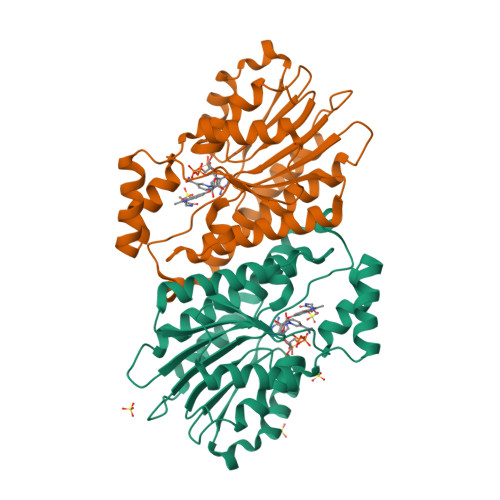
Top ▲

GtoPdb is requesting financial support from commercial users. Please see our sustainability page for more information.
Gene and Protein Information  |
||||||
| Species | TM | AA | Chromosomal Location | Gene Symbol | Gene Name | Reference |
| Human | - | 261 | 2p13.2 | SPR | sepiapterin reductase | |
| Mouse | - | 262 | 6 C3; 6 37.15 cM | Spr | sepiapterin reductase | |
| Rat | - | 262 | 4q34 | Spr | sepiapterin reductase | |
Previous and Unofficial Names  |
| SDR38C1 | sepiapterin reductase (L-erythro-7,8-dihydrobiopterin forming) | short chain dehydrogenase/reductase family 38C, member 1 |
Database Links  |
|
| Alphafold | P35270 (Hs), P18297 (Rn) |
| BRENDA | 1.1.1.153 |
| ChEMBL Target | CHEMBL3988583 (Hs) |
| Ensembl Gene | ENSG00000116096 (Hs), ENSMUSG00000033735 (Mm), ENSRNOG00000015455 (Rn) |
| Entrez Gene | 6697 (Hs), 20751 (Mm), 29270 (Rn) |
| Human Protein Atlas | ENSG00000116096 (Hs) |
| KEGG Enzyme | 1.1.1.153 |
| KEGG Gene | hsa:6697 (Hs), mmu:20751 (Mm), rno:29270 (Rn) |
| OMIM | 182125 (Hs) |
| Pharos | P35270 (Hs) |
| RefSeq Nucleotide | NM_011467 (Hs), NM_003124 (Hs), NM_019181 (Rn) |
| RefSeq Protein | NP_003115 (Hs), NP_035597 (Mm), NP_062054 (Rn) |
| UniProtKB | P35270 (Hs), P18297 (Rn) |
| Wikipedia | SPR (Hs) |
Selected 3D Structures  |
|||||||||||||

|
|
||||||||||||
Enzyme Reaction  |
||||||||||
|
||||||||||
Download all structure-activity data for this target as a CSV file 
| Inhibitors | |||||||||||||||||||||||||||||||||||||||||||||||||||
| Key to terms and symbols | View all chemical structures | Click column headers to sort | |||||||||||||||||||||||||||||||||||||||||||||||||
|
|||||||||||||||||||||||||||||||||||||||||||||||||||
| Immunopharmacology Comments |
| BH4 has been reported as a crucial regulator of T cell function and proliferation [2]. As a result, modulation of enzymes in the BH4 biosynthesis pathway has been suggested as a novel mechanistic approach for the treatment of autoimmune diseases (pathway inhibitors to reduce T cell activity) and anticancer immunity (pathway activators to enhance T cell effector function). In support of this hypothesis, the sepiapterin reductase (SPR; the terminal enzyme in BH4 biosynthesis) inhibitor SPRi3, has been shown to reduce neuropathic and inflammatory pain in vivo [3]. |
| General Comments |
| SPR is an aldo-keto reductase that catalyses the terminal reaction in the biosynthesis of tetrahydrobiopterin (BH4, sapropterin) from GTP. |
1. Blagg J. (2011) Sepiapterin reductase inhibitors for the treatment of pain. Patent number: WO2011047156A1. Assignee: Hercules Technology Management Co V, Inc.. Priority date: 15/10/2009. Publication date: 21/04/2011.
2. Cronin SJF, Seehus C, Weidinger A, Talbot S, Reissig S, Seifert M, Pierson Y, McNeill E, Longhi MS, Turnes BL et al.. (2018) The metabolite BH4 controls T cell proliferation in autoimmunity and cancer. Nature, 563 (7732): 564-568. [PMID:30405245]
3. Latremoliere A, Latini A, Andrews N, Cronin SJ, Fujita M, Gorska K, Hovius R, Romero C, Chuaiphichai S, Painter M et al.. (2015) Reduction of Neuropathic and Inflammatory Pain through Inhibition of the Tetrahydrobiopterin Pathway. Neuron, 86 (6): 1393-406. [PMID:26087165]
1.-.-.- Oxidoreductases: sepiapterin reductase. Last modified on 12/11/2018. Accessed on 12/07/2025. IUPHAR/BPS Guide to PHARMACOLOGY, https://www.guidetopharmacology.org/GRAC/ObjectDisplayForward?objectId=3020.